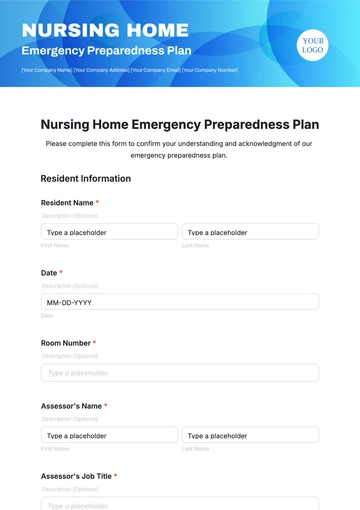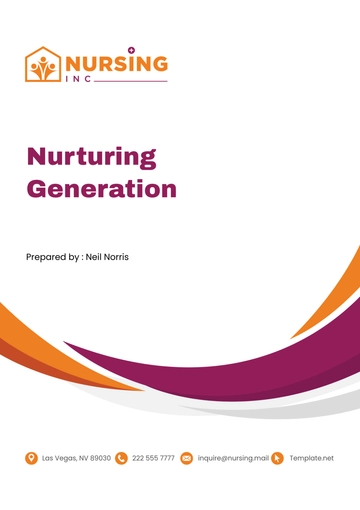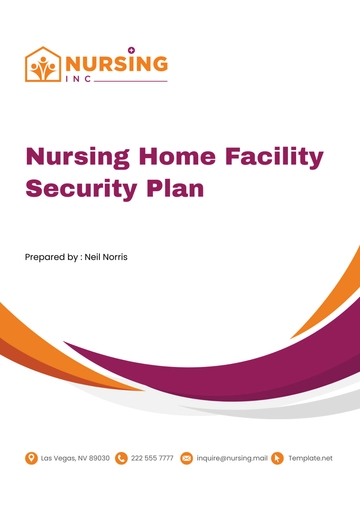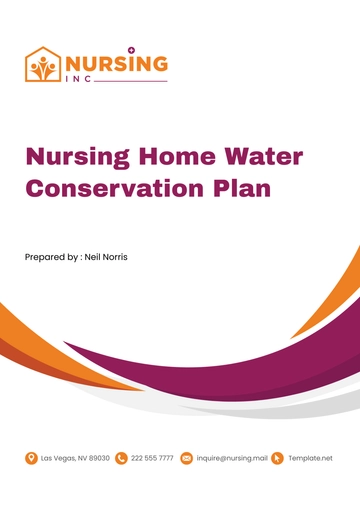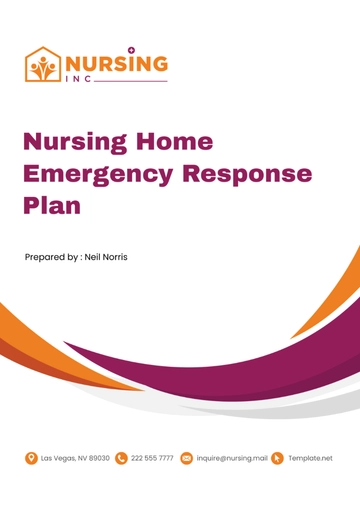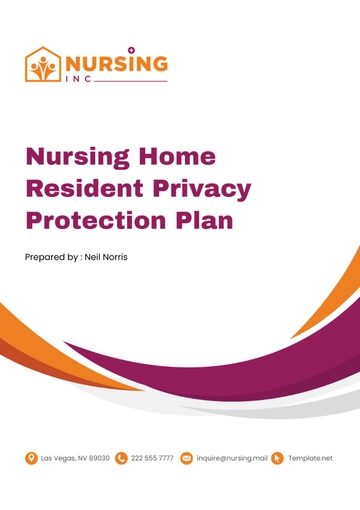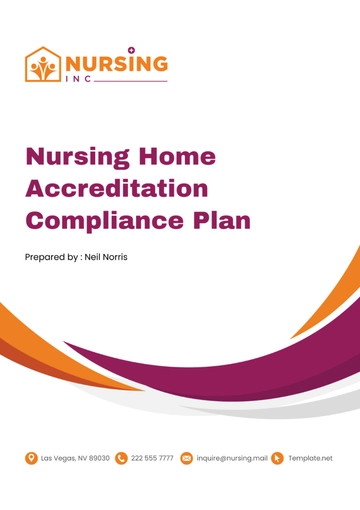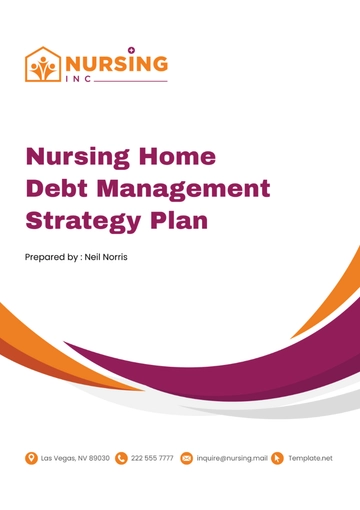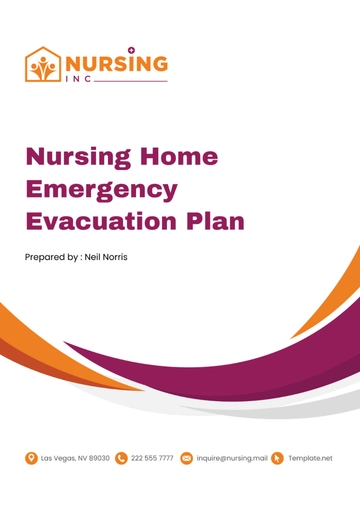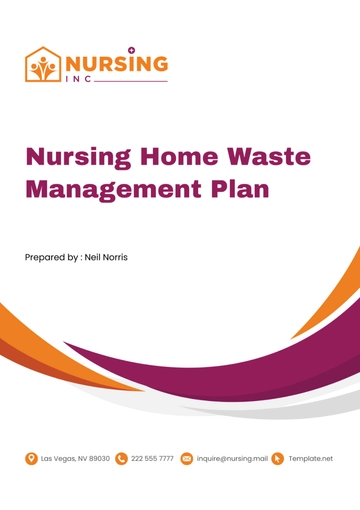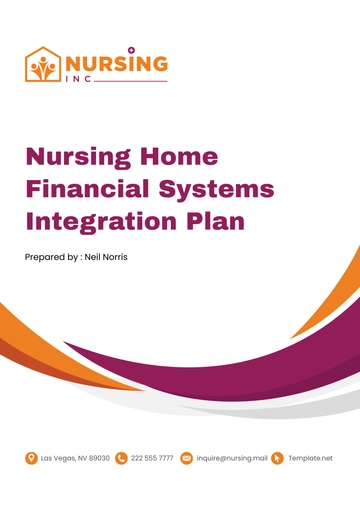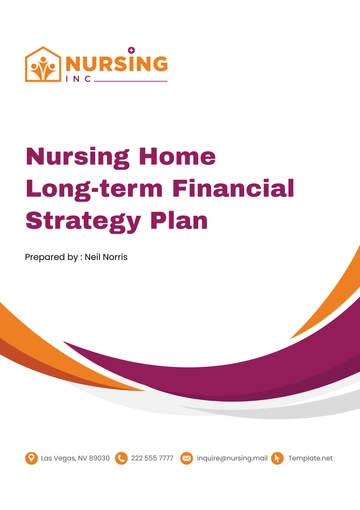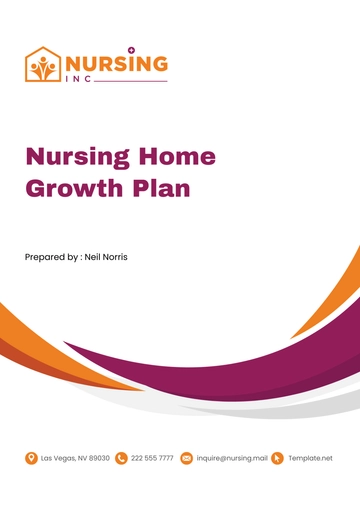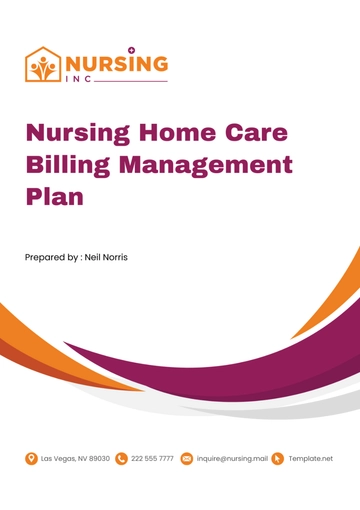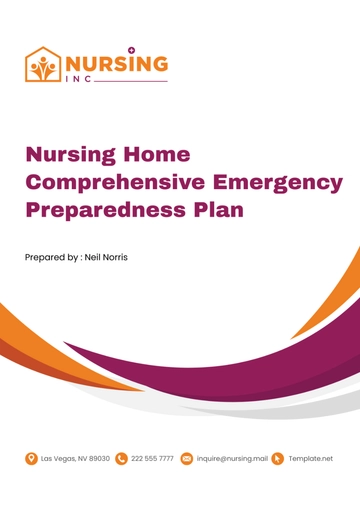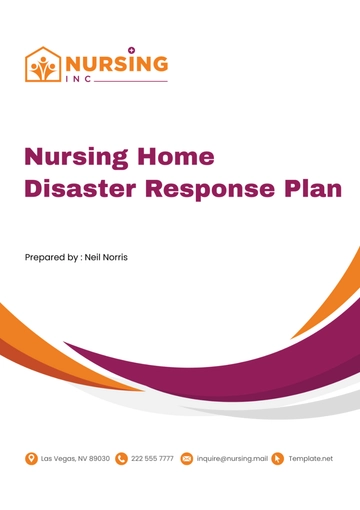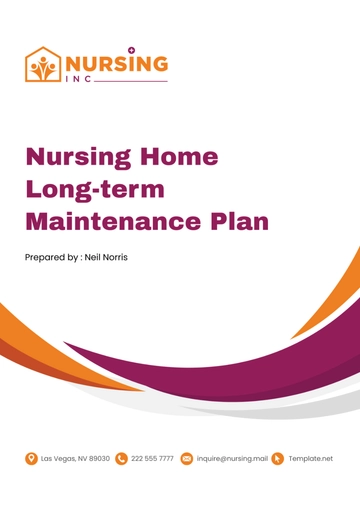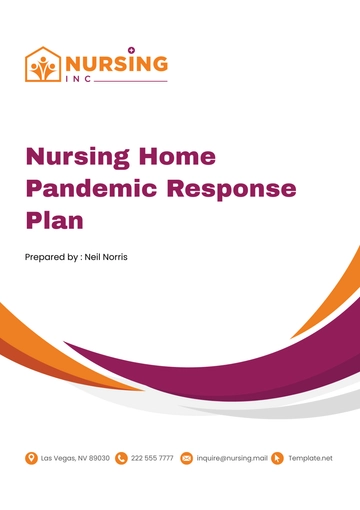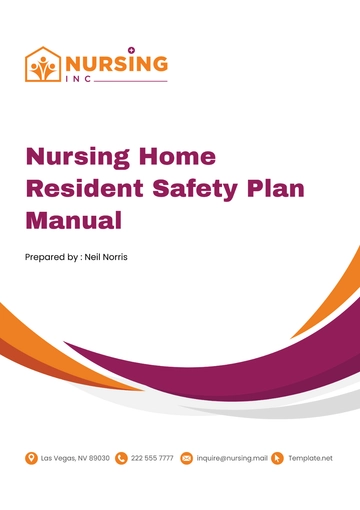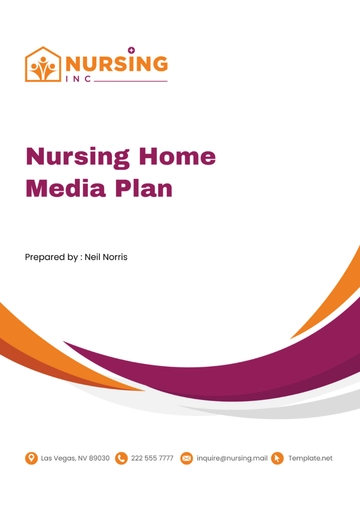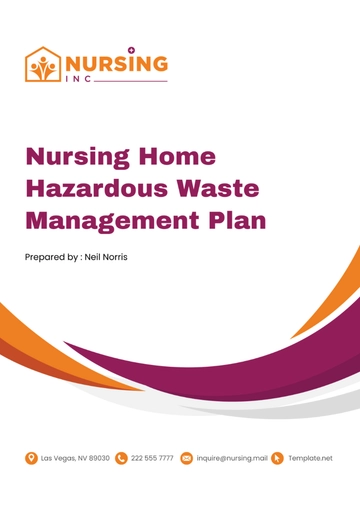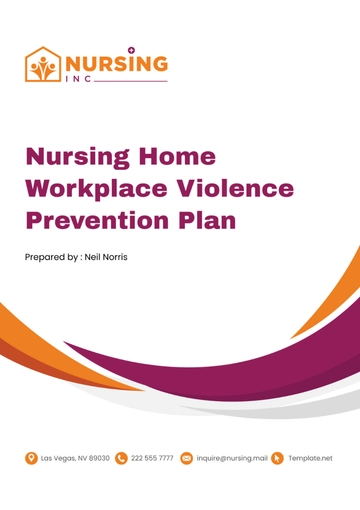Free Nursing Home Disaster Response Plan
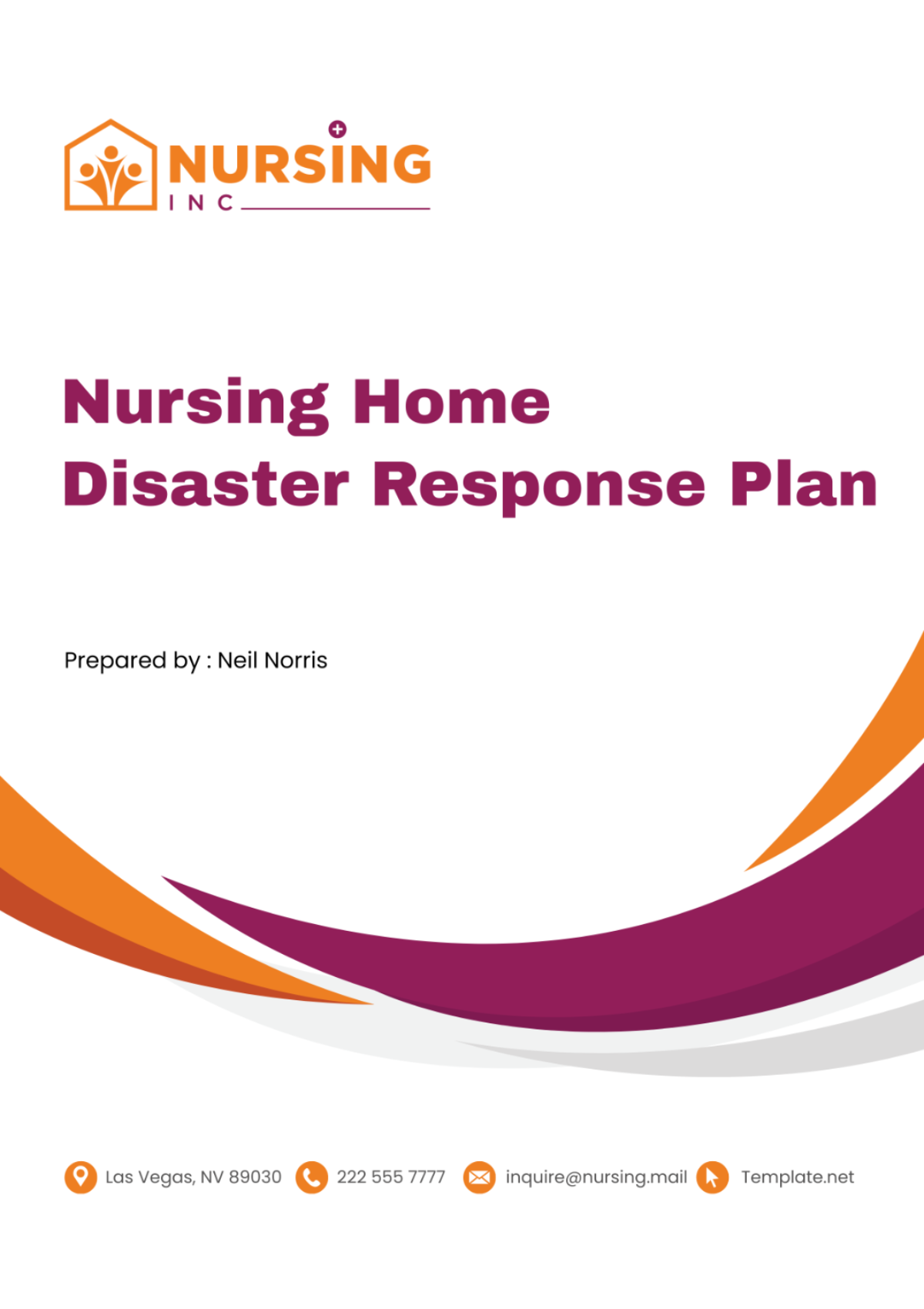
I. Introduction
A. Purpose
The primary objective of the Nursing Home Disaster Response Plan is to establish comprehensive procedures and protocols to ensure the safety, security, and well-being of residents, staff, and visitors during emergency situations. The plan aims to mitigate the impact of various hazards and disasters, including natural calamities, such as hurricanes, earthquakes, and floods, as well as man-made emergencies like fires, power outages, and chemical spills. By outlining clear roles, responsibilities, and actions, this plan intends to facilitate an organized and effective response to emergencies, minimize potential risks, and safeguard the continuity of essential services within [Your Company Name] nursing home facilities.
The plan further seeks to adhere to regulatory requirements and industry best practices, including those outlined by relevant authorities such as the Federal Emergency Management Agency (FEMA), the Centers for Medicare & Medicaid Services (CMS), and state and local health departments. It underscores the commitment of [Your Company Name] to prioritize the safety and well-being of its residents and staff members, uphold ethical standards of care, and maintain public trust and confidence in its operations, even in challenging circumstances.
B. Scope
This plan encompasses all [Your Company Name] nursing home facilities, including [insert number] locations across [insert regions]. It applies to all personnel, including administrators, healthcare professionals, support staff, and volunteers, involved in the care and management of residents within these facilities. The plan is designed to be adaptable and scalable to address various types and magnitudes of emergencies, considering the unique characteristics and vulnerabilities of each facility. Additionally, it serves as a framework for collaboration with external agencies, emergency responders, and community partners to enhance preparedness, response, and recovery efforts in the event of a disaster.
Recognizing the dynamic nature of emergencies and the evolving landscape of threats and hazards, this plan emphasizes the importance of continuous improvement, regular training, and exercises to test and refine emergency procedures. It encourages active participation and engagement from all stakeholders, including residents, families, local community organizations, and government agencies, to foster a culture of preparedness and resilience.
C. Definitions
Disaster: A significant event or occurrence, natural or human-induced, that disrupts normal operations, poses a threat to life, property, and the environment, and requires a coordinated response to mitigate its impact. Disasters may include but are not limited to, hurricanes, earthquakes, floods, fires, pandemics, terrorist attacks, and mass casualty incidents.
Emergency Response Team (ERT): A designated group of individuals appointed to lead and coordinate emergency response activities, including preparedness, mitigation, response, and recovery efforts, within [Your Company Name] nursing home facilities. The ERT comprises representatives from various departments and disciplines, including administration, nursing, environmental services, security, and maintenance, tasked with specific roles and responsibilities during emergencies.
II. Risk Assessment
A. Identification of Hazards
Natural Hazards:
a. Severe Weather:
[Your Company Name] nursing homes are situated in regions prone to severe weather events, including hurricanes, tornadoes, and severe thunderstorms. These weather phenomena can result in strong winds, heavy rainfall, flooding, and storm surges, leading to structural damage, power outages, transportation disruptions, and communication breakdowns.
b. Earthquakes:
While earthquakes are less common in some regions, [Your Company Name] acknowledges the potential risk posed by seismic activity. Even moderate earthquakes can cause structural damage to buildings, infrastructure, and utilities, posing risks to resident safety and operational continuity.
c. Flooding:
Low-lying areas near rivers, lakes, or coastal regions are susceptible to flooding during periods of intense rainfall, tropical storms, or hurricanes. Flooding can inundate facilities, compromise access roads, disrupt utilities, and pose health risks due to water contamination and mold growth.
Man-made Hazards:
a. Fire:
Fires can occur due to various factors, including electrical malfunctions, cooking accidents, heating equipment failures, or arson. In a nursing home setting, fires present immediate threats to resident safety, staff, and property, requiring swift evacuation, firefighting efforts, and medical interventions.
b. Power Outages:
Disruptions to the electrical grid can occur due to severe weather, equipment failures, grid overloads, or intentional actions. Power outages jeopardize essential services, medical equipment operations, environmental controls, and communication systems, necessitating contingency plans and backup power solutions.
c. Chemical Spills:
Proximity to industrial facilities, transportation routes, or hazardous material storage areas increases the risk of chemical spills or releases. Exposure to hazardous chemicals can lead to respiratory irritation, skin burns, or toxic effects, requiring evacuation, decontamination, and medical treatment protocols.
B. Vulnerability Analysis
[Your Company Name] conducts vulnerability assessments to identify and evaluate potential risks posed by hazards to residents, staff, infrastructure, and operations within nursing home facilities. The vulnerability analysis considers various factors, including:
Facility Characteristics:
Age, design, construction materials, and structural integrity of buildings.
Location of critical infrastructure, utilities, and emergency systems.
Accessibility features for residents with mobility impairments or disabilities.
Resident Population:
Age, health status, medical conditions, and mobility levels of residents.
Special needs, dependencies, or vulnerabilities requiring specialized care or assistance.
Capacity for independent evacuation or reliance on staff support during emergencies.
Staffing and Resources:
Availability of trained personnel, including healthcare professionals, support staff, and volunteers.
Adequacy of staffing levels to meet resident care needs and emergency response requirements.
Availability of essential resources, including medical supplies, food, water, and emergency equipment.
External Factors:
Surrounding environment, including proximity to floodplains, coastal areas, or industrial zones.
Local climate patterns, historical data on natural disasters, and community resilience measures.
Regulatory requirements, building codes, and standards governing emergency preparedness and safety practices.
C. Risk Evaluation
Risk evaluation involves assessing the likelihood and potential consequences of identified hazards to determine their level of risk and prioritize preparedness measures. [Your Company Name] employs qualitative and quantitative methods to evaluate risks, considering factors such as:
Probability of Occurrence:
Likelihood of specific hazards occurring within the facility's geographic area, based on historical data, hazard assessments, and expert opinions.
Frequency and severity of past incidents or near misses related to natural disasters, fires, power outages, or other emergencies.
Potential Impact:
Potential consequences of hazards on resident safety, health, and well-being, including injuries, illnesses, fatalities, and psychological trauma.
Extent of damage to facility infrastructure, equipment, and operations, leading to disruptions in care delivery, financial losses, and reputational damage.
Risk Severity:
Categorization of risks based on their severity, ranging from low-risk events with minimal impact to high-risk scenarios posing significant threats to life, property, and the environment.
Prioritization of risks for mitigation, preparedness, and response efforts, focusing on those with the highest severity and potential consequences.
III. Planning and Preparedness
A. Emergency Response Team
The Emergency Response Team (ERT) plays a pivotal role in implementing the Nursing Home Disaster Response Plan. The team consists of designated individuals representing different departments and disciplines within [Your Company Name] nursing home facilities. Each member has specific roles and responsibilities tailored to their expertise and training. The composition of the ERT may include:
Role | Responsibilities |
|---|---|
Incident Commander | Overall coordination and decision-making during emergencies. |
Safety Officer | Monitors and assesses safety hazards and ensures compliance with safety protocols. |
Medical Coordinator | Oversees medical care, triage, and evacuation of residents requiring medical attention. |
Operations Manager | Manages facility operations, including resource allocation, logistics, and communications. |
Nursing Supervisor | Coordinates nursing staff activities, patient care, and medication management. |
Facilities Manager | Assesses facility infrastructure, utilities, and maintenance needs. |
Communication Liaison | Facilitates internal and external communication, including updates to staff, residents, families, and external agencies. |
B. Communication Plan
Effective communication is critical for coordinating response efforts, disseminating information, and ensuring the safety and well-being of residents, staff, and stakeholders. The Communication Plan outlines communication protocols, channels, and procedures to be followed before, during, and after emergencies. Key components of the Communication Plan include:
Primary Communication Channels:
Two-way radios for internal communication among staff members.
Telephone systems for external communication with emergency services, families, and stakeholders.
Public address systems for broadcasting announcements and instructions to residents and staff.
Chain of Command:
Establish a clear chain of command to facilitate efficient decision-making and information flow during emergencies.
Designate communication liaisons responsible for relaying updates and instructions between the Incident Commander, ERT members, and external agencies.
Communication Procedures:
Define protocols for initiating emergency notifications, including the activation of alarms, alerts, and public announcements.
Establish communication checkpoints and reporting mechanisms to monitor the status of residents, staff, and facility operations.
C. Evacuation Plan
The Evacuation Plan outlines procedures for safely evacuating residents from [Your Company Name] nursing home facilities in the event of emergencies, such as fires, floods, or chemical spills. It includes:
Evacuation Routes:
Identify primary and alternative evacuation routes based on facility layout, accessibility, and potential hazards.
Map out evacuation routes to designated assembly areas or relocation sites outside the facility.
Evacuation Procedures:
Assign staff members to assist residents with mobility impairments or special needs during evacuation.
Conduct regular evacuation drills to familiarize staff and residents with evacuation procedures and routes.
Transportation and Sheltering:
Coordinate transportation arrangements with local authorities, transportation providers, or neighboring facilities for evacuating residents to safe locations.
Establish agreements with nearby shelters or healthcare facilities to accommodate evacuated residents if necessary.
D. Shelter-in-Place Plan
In certain emergency scenarios where evacuation is not feasible or safe, [Your Company Name] nursing home facilities may implement shelter-in-place procedures. The Shelter-in-Place Plan outlines protocols for securing the facility and ensuring the safety of residents and staff indoors. Key components of the plan include:
Secure Shelter Areas:
Identify designated shelter areas within the facility that provide protection from external hazards, such as severe weather or chemical releases.
Ensure shelter areas are equipped with emergency supplies, including water, food, first aid kits, and communication devices.
Environmental Controls:
Activate HVAC systems to maintain indoor air quality and temperature within shelter areas.
Seal doors, windows, and other openings to prevent the ingress of smoke, fumes, or contaminants from external sources.
Monitoring and Communication:
Assign staff members to monitor conditions inside the shelter and provide regular updates to the Incident Commander and ERT.
Establish communication protocols for maintaining contact with external emergency services and coordinating any necessary assistance or support.
E. Medical Supplies and Equipment
Maintaining an adequate supply of medical equipment, medications, and emergency provisions is essential for supporting resident care during emergencies. The Nursing Home Disaster Response Plan includes provisions for:
Emergency Medical Kits:
Stockpile emergency medical kits containing essential supplies, medications, and medical equipment for use during disasters.
Regularly inspect and replenish medical kits to ensure readiness and compliance with regulatory requirements.
Oxygen and Respiratory Equipment:
Ensure sufficient supplies of oxygen cylinders, concentrators, and respiratory therapy equipment for residents with respiratory conditions.
Develop procedures for managing oxygen therapy and ensuring uninterrupted access to respiratory support during emergencies.
Power Backup Systems:
Install backup power generators to maintain essential medical equipment, environmental controls, and communication systems during power outages.
Conduct routine testing and maintenance of backup power systems to verify functionality and reliability during emergencies.
IV. Response
A. Activation of Emergency Response Team
In the event of an emergency or disaster, the Emergency Response Team (ERT) at [Your Company Name] nursing home facilities will be promptly activated to initiate and coordinate response efforts. The activation process involves:
Notification:
Upon detection or receipt of an emergency alert or notification, designated personnel, such as the Incident Commander or Safety Officer, will immediately initiate the response protocol.
Notification mechanisms may include audible alarms, electronic alerts, communication systems, or direct verbal communication among staff members.
Assembly of ERT:
ERT members will assemble at the designated command center or emergency operations center within the facility to coordinate response activities.
The Incident Commander will assume overall command and control of the response operation and delegate specific tasks and responsibilities to ERT members based on their roles and expertise.
Briefing and Situation Assessment:
The Incident Commander will conduct a preliminary briefing to provide an overview of the emergency situation, assess the severity and scope of the incident, and identify immediate priorities and objectives.
ERT members will gather relevant information, assess the status of residents, staff, and facility infrastructure, and establish communication channels with external agencies and stakeholders as needed.
B. Communication Protocols
Effective communication is essential for coordinating response efforts, disseminating information, and maintaining situational awareness during emergencies. [Your Company Name] nursing home facilities utilize established communication protocols to ensure timely and accurate exchange of information. Key aspects of communication protocols include:
Internal Communication:
ERT members communicate using designated communication devices, such as two-way radios, mobile phones, or communication apps, to relay updates, instructions, and status reports.
Regular briefings and updates are conducted to keep staff informed of the evolving situation, response activities, and safety protocols.
External Communication:
Communication liaisons or designated staff members maintain contact with external agencies, emergency services, and community partners to request assistance, share critical information, and coordinate support efforts.
Communication channels may include telephone, email, radio communication, or web-based platforms, depending on the nature and scope of the emergency.
Public Information:
Public address systems, signage, and written notifications are used to communicate with residents, families, visitors, and external stakeholders regarding emergency procedures, evacuation instructions, and safety precautions.
Regular updates and announcements are provided through official communication channels to address concerns, provide reassurance, and promote transparency throughout the response operation.
C. Evacuation Procedures
If evacuation is necessary to ensure the safety of residents and staff, [Your Company Name] nursing home facilities will implement established evacuation procedures. These procedures include:
Resident Evacuation:
Staff members will assist residents in evacuating to designated assembly areas or evacuation points following established evacuation routes and procedures.
Special attention will be given to residents with mobility impairments, medical needs, or cognitive challenges to ensure their safe and orderly evacuation.
Transportation Arrangements:
Coordination with local authorities, transportation providers, or neighboring facilities will be made to arrange transportation for evacuated residents to safe locations.
Emergency vehicles, buses, or other transportation assets may be utilized to facilitate the evacuation process and ensure timely relocation of residents.
Communication and Accountability:
Communication liaisons or designated staff members will maintain communication with the Incident Commander and ERT to provide updates on evacuation progress, status of residents, and any emerging issues.
Accountability measures, such as resident checklists, tracking systems, or electronic databases, will be used to account for all evacuated residents and ensure no one is left behind during the evacuation process.
D. Medical Care and Support
During emergencies, [Your Company Name] nursing home facilities prioritize the provision of medical care and support to residents, addressing their immediate health needs and ensuring continuity of care. Key aspects of medical care and support include:
Triage and Assessment:
Medical personnel will conduct triage assessments to prioritize care based on the severity of injuries, illnesses, or medical conditions.
Residents requiring urgent medical attention will receive immediate intervention, stabilization, and treatment as appropriate.
Medical Supplies and Equipment:
Emergency medical kits, supplies, and medications will be readily available and accessible to staff for use in providing medical care and addressing emergent needs.
Medical equipment, such as defibrillators, oxygen therapy devices, and vital sign monitors, will be operational and properly maintained to support patient care.
Coordination with External Resources:
Collaboration with emergency medical services (EMS), hospitals, and healthcare partners will be established to facilitate the transfer of residents requiring higher levels of care or specialized medical services.
Requests for additional medical resources, personnel, or supplies will be communicated to external agencies and coordinated through established channels to augment onsite capabilities.
Psychological Support:
Staff members will provide emotional support, reassurance, and comfort to residents experiencing stress, anxiety, or trauma as a result of the emergency.
Counseling services, peer support groups, and spiritual care resources may be offered to residents and families to address psychological needs and promote resilience during challenging times.
V. Recovery
A. Return to Normal Operations
Following the resolution of the emergency situation, [Your Company Name] nursing home facilities will initiate the recovery phase to restore normal operations and resume providing quality care to residents. The recovery process involves several key steps:
Damage Assessment:
Conduct thorough assessments of facility infrastructure, equipment, and systems to identify any damage or deficiencies resulting from the emergency.
Prioritize repairs and restoration efforts based on criticality and impact on resident care and safety.
Facility Cleanup and Restoration:
Coordinate cleanup and restoration activities to address any environmental hazards, debris, or contamination within the facility.
Engage qualified contractors and vendors to expedite repairs and restoration of damaged areas and equipment.
Resumption of Services:
Gradually resume normal operations and services, including resident care, dining services, recreational activities, and therapy programs.
Communicate with residents, families, and staff regarding the resumption of services and any temporary adjustments or accommodations.
Regulatory Compliance:
Ensure compliance with regulatory requirements, including reporting obligations, documentation of actions taken, and coordination with regulatory agencies as needed.
Implement corrective actions and preventive measures to mitigate future risks and improve emergency preparedness and response capabilities.
B. Psychological Support for Residents and Staff
The aftermath of an emergency or disaster can have profound emotional and psychological effects on residents and staff. [Your Company Name] nursing home facilities are committed to providing comprehensive support and resources to address the psychological needs of individuals affected by the emergency. Key components of the psychological support program include:
Counseling Services:
Offer counseling services and emotional support to residents, families, and staff members impacted by the emergency.
Engage licensed counselors, psychologists, or social workers to provide individual or group counseling sessions as needed.
Trauma-Informed Care:
Implement trauma-informed care practices to recognize and respond to the emotional trauma experienced by residents and staff.
Train staff members on techniques for providing compassionate and empathetic care to individuals affected by trauma.
Support Groups and Peer Networks:
Facilitate support groups and peer networks where residents and staff can share their experiences, coping strategies, and emotional support.
Encourage open communication and active listening to validate feelings and foster a sense of community and resilience.
Education and Awareness:
Educate residents, families, and staff about common reactions to trauma, coping mechanisms, and available support services.
Promote awareness of mental health resources and encourage individuals to seek help if experiencing distress or emotional difficulties.
C. Review and Lessons Learned
The final phase of the Nursing Home Disaster Response Plan involves conducting a comprehensive review of the emergency response and recovery efforts to identify strengths, areas for improvement, and lessons learned. This process facilitates continuous improvement and enhances the preparedness and resilience of [Your Company Name] nursing home facilities for future emergencies. Key components of the review and lessons learned process include:
After-Action Review (AAR):
Gather feedback from key stakeholders, including ERT members, staff, residents, families, and external partners, regarding their experiences and observations during the emergency.
Conduct structured AAR meetings to discuss successes, challenges, and opportunities for improvement in emergency preparedness, response, and recovery efforts.
Documentation and Documentation:
Document all actions taken, decisions made, and communications exchanged during the emergency response and recovery phases.
Compile incident reports, logs, and other relevant documentation to provide a comprehensive record of the emergency situation and the organization's response.
Identify Lessons Learned:
Analyze the findings from the AAR and documentation review to identify recurring themes, root causes of issues, and opportunities for enhancement.
Prioritize actionable recommendations and lessons learned to inform updates to policies, procedures, and training programs.
Plan Updates and Continuous Improvement:
Update the Nursing Home Disaster Response Plan based on lessons learned and recommendations identified during the review process.
Incorporate feedback and insights from stakeholders to enhance the effectiveness, clarity, and usability of the plan for future emergencies.
- 100% Customizable, free editor
- Access 1 Million+ Templates, photo’s & graphics
- Download or share as a template
- Click and replace photos, graphics, text, backgrounds
- Resize, crop, AI write & more
- Access advanced editor
Prepare for emergencies with the Nursing Home Disaster Response Plan Template from Template.net. Editable and customizable, it outlines protocols for responding to various disasters and emergencies in nursing home facilities. Tailor it effortlessly using our Ai Editor Tool for personalized plans. Ensure readiness and protect residents and staff with this essential template.
You may also like
- Finance Plan
- Construction Plan
- Sales Plan
- Development Plan
- Career Plan
- Budget Plan
- HR Plan
- Education Plan
- Transition Plan
- Work Plan
- Training Plan
- Communication Plan
- Operation Plan
- Health And Safety Plan
- Strategy Plan
- Professional Development Plan
- Advertising Plan
- Risk Management Plan
- Restaurant Plan
- School Plan
- Nursing Home Patient Care Plan
- Nursing Care Plan
- Plan Event
- Startup Plan
- Social Media Plan
- Staffing Plan
- Annual Plan
- Content Plan
- Payment Plan
- Implementation Plan
- Hotel Plan
- Workout Plan
- Accounting Plan
- Campaign Plan
- Essay Plan
- 30 60 90 Day Plan
- Research Plan
- Recruitment Plan
- 90 Day Plan
- Quarterly Plan
- Emergency Plan
- 5 Year Plan
- Gym Plan
- Personal Plan
- IT and Software Plan
- Treatment Plan
- Real Estate Plan
- Law Firm Plan
- Healthcare Plan
- Improvement Plan
- Media Plan
- 5 Year Business Plan
- Learning Plan
- Marketing Campaign Plan
- Travel Agency Plan
- Cleaning Services Plan
- Interior Design Plan
- Performance Plan
- PR Plan
- Birth Plan
- Life Plan
- SEO Plan
- Disaster Recovery Plan
- Continuity Plan
- Launch Plan
- Legal Plan
- Behavior Plan
- Performance Improvement Plan
- Salon Plan
- Security Plan
- Security Management Plan
- Employee Development Plan
- Quality Plan
- Service Improvement Plan
- Growth Plan
- Incident Response Plan
- Basketball Plan
- Emergency Action Plan
- Product Launch Plan
- Spa Plan
- Employee Training Plan
- Data Analysis Plan
- Employee Action Plan
- Territory Plan
- Audit Plan
- Classroom Plan
- Activity Plan
- Parenting Plan
- Care Plan
- Project Execution Plan
- Exercise Plan
- Internship Plan
- Software Development Plan
- Continuous Improvement Plan
- Leave Plan
- 90 Day Sales Plan
- Advertising Agency Plan
- Employee Transition Plan
- Smart Action Plan
- Workplace Safety Plan
- Behavior Change Plan
- Contingency Plan
- Continuity of Operations Plan
- Health Plan
- Quality Control Plan
- Self Plan
- Sports Development Plan
- Change Management Plan
- Ecommerce Plan
- Personal Financial Plan
- Process Improvement Plan
- 30-60-90 Day Sales Plan
- Crisis Management Plan
- Engagement Plan
- Execution Plan
- Pandemic Plan
- Quality Assurance Plan
- Service Continuity Plan
- Agile Project Plan
- Fundraising Plan
- Job Transition Plan
- Asset Maintenance Plan
- Maintenance Plan
- Software Test Plan
- Staff Training and Development Plan
- 3 Year Plan
- Brand Activation Plan
- Release Plan
- Resource Plan
- Risk Mitigation Plan
- Teacher Plan
- 30 60 90 Day Plan for New Manager
- Food Safety Plan
- Food Truck Plan
- Hiring Plan
- Quality Management Plan
- Wellness Plan
- Behavior Intervention Plan
- Bonus Plan
- Investment Plan
- Maternity Leave Plan
- Pandemic Response Plan
- Succession Planning
- Coaching Plan
- Configuration Management Plan
- Remote Work Plan
- Self Care Plan
- Teaching Plan
- 100-Day Plan
- HACCP Plan
- Student Plan
- Sustainability Plan
- 30 60 90 Day Plan for Interview
- Access Plan
- Site Specific Safety Plan
